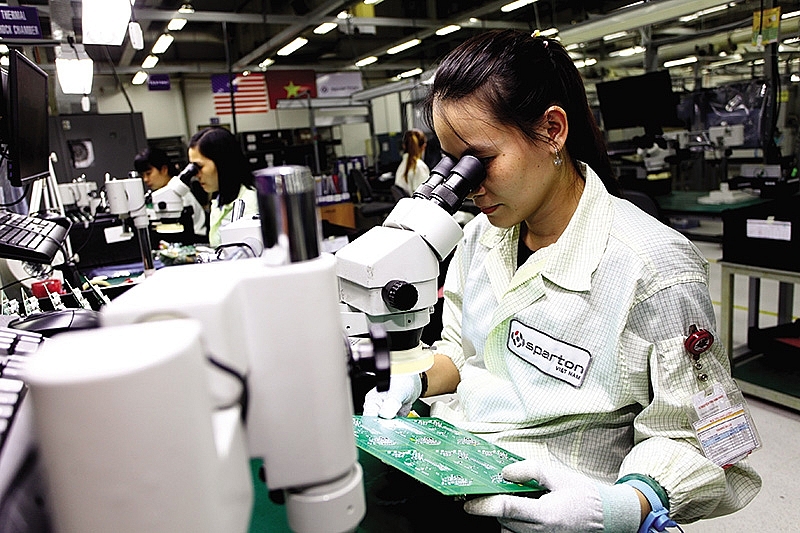Industrial production on a high
 |
| The 11.2 per cent IIP climb in the year’s first eight months has reflected businesses’ growing confidence, Photo: Le Toan |
During his working visit to South Korea’s Samsung Display Vietnam (SDV) facility in the northern province of Bac Ninh two weeks ago, Minister of Planning and Investment Nguyen Chi Dung was told that in the first half of this year, SDV’s export turnover hit $3.7 billion and revenue totalled $6.6 billion. Since its establishment in late 2014, the manufacturer, which produces OLED screens for phones, tablets, and watches, has disbursed $6.3 billion out of its total committed $6.5 billion. The remaining $200 million will be disbursed in the third quarter, much earlier than the company’s initially scheduled target of 2022.
“Samsung Display Vietnam has made a great contribution to the development of Bac Ninh in particular and of Vietnam in general,” Minister Dung said.
The General Statistics Office (GSO) last week reported that in the first eight months of this year, thanks to boosted production of the business community including large-scale manufacturers like Samsung and Formosa in Vietnam, the index of industrial production (IIP) climbed to the highest eight-month level since 2011, at a growth of 11.2 per cent on-year. Breaking down this 11.2 per cent rise, the manufacturing and processing sector, which accounts for nearly 80 per cent of Vietnam’s industrial growth, saw the highest eight-month growth rate at 13.3 per cent, contributing to 10.2 per cent of IIP growth. Meanwhile, production and distribution of electricity grew by 10.4 per cent, far higher than the 8.6 per cent rise in the same period last year.
“The 11.2 per cent IIP rise is very significant, reflecting major growth in industrial production,” said Mai Tien Dung, Minister and Chairman of the Government Office. “Never have we seen such strong growth in IIP as we are doing now. Production of almost all products in the economy has also soared, and the business community’s confidence is growing strongly.”
For example, showing the business community’s growing confidence, last week, a joint venture between Wagan, GHN Group, Masters Depot, and Vietnam’s Tin Thanh Group met with the operator of Dung Quat Oil Refinery in the south-central province of Quang Ngai, in hopes of engaging in the second-phase expansion of the project. As scheduled, the expansion will be completed in 2021, with the refinery’s capacity to be increased by 30 per cent, with an output of 8.5 million tonnes of EURO-standard products per year. In the first eight months of this year, the refinery produced over 4.71 million tonnes of oil, with revenue of over VND73.9 trillion ($3.27 billion).
According to the GSO, since the beginning of the year, many industrial products have witnessed very high growth, including petrol and oil (up 50 per cent on-year), steel (up 37.6 per cent, largely owing to Formosa, which helped the central province of Ha Tinh’s IIP top the country at 121.4 per cent), mobile phones and their spare parts (up 36.6 per cent, mostly thanks to Samsung), alumina (up 25.2 per cent), and liquified petroleum gas (up 24.9 per cent).
Standard Chartered Bank expects that industrial manufacturing and construction are likely to remain “the fastest-growing sectors” in Vietnam, and this will help the economy grow at a high rate – 7 per cent in 2018, higher than its previous forecast of 6.8 per cent, “with all domestic engines firing together”.
“We are positive on Vietnam’s growth in the medium term based on strong manufacturing activity, as foreign direct investment (FDI) inflows to manufacturing remain strong. We believe that Vietnam will remain one of the fastest-growing economies in Asia in 2018,” said Chidu Narayanan, economist for Asia at Standard Chartered Bank.
According to the bank, FDI inflows are set to remain high in 2018, led by manufacturing, which makes up close to 50 per cent of the inflows.
The GSO also said that in the first eight months, FDI disbursement totalled $11.25 billion, up 9.2 per cent on-year.
Besides, Vietnam also saw nearly 87,500 enterprises newly established, registered at $38.87 billion, up 2.4 per cent in the number of enterprises and 6.9 per cent in capital, on-year.
In addition, operational companies increased their capital by $74.3 billion. Thus, the total new capital inserted into the economy in the first eight months of 2018 hit $113.17 billion.
What the stars mean:
★ Poor ★ ★ Promising ★★★ Good ★★★★ Very good ★★★★★ Exceptional
 Tag:
Tag:
Related Contents
Latest News
More News
- Vietnam’s green transition demands collective financial action (December 15, 2025 | 12:00)
- VIR workshop highlights capital and policy for sustainable development (December 15, 2025 | 11:00)
- National Assembly approves pilot mechanisms to accelerate major projects in Hanoi (December 12, 2025 | 11:29)
- Vietnam eases policy approval requirements, simplifies foreign and outbound investments (December 11, 2025 | 17:53)
- Unpacking new momentum in Vietnam’s M&A market (December 10, 2025 | 09:59)
- Forum honours outstanding M&A deals, strategies, and advisory firms (December 09, 2025 | 18:22)
- Vietnam enters defining phase of M&A growth (December 09, 2025 | 17:00)
- Vietnam’s M&A market opens new opportunities amid strong economic momentum (December 09, 2025 | 15:00)
- Vietnam M&A Forum 2025: new position, new momentum (December 09, 2025 | 14:30)
- FDI in Vietnam jumps on additional capital and share purchases (December 09, 2025 | 13:56)
























 Mobile Version
Mobile Version